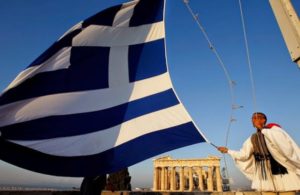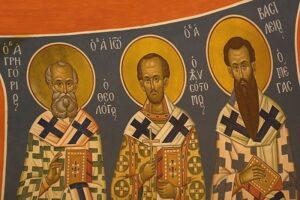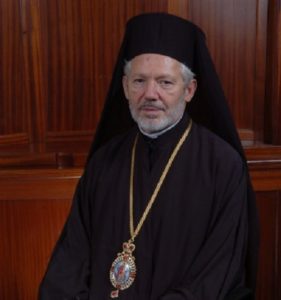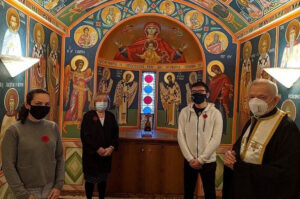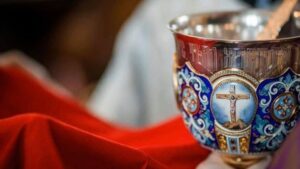Orthodoxy and the West- Historical Observations and Contemporary Thoughts
17 August 2016It is commonly agreed that the end of the second millennium after Christ was marked by a succession of events, by unexpected historical changes, which shook even those societies which traditionally had a sense of security and self-sufficiency. It is not possible to tell if people today are entering the historical era of the third millennium with any awareness, or whether events are progressing at such a rate that we are left trailing, in fetters, in the wake of a course which we are unable to influence. In the East and West today, there is a growing feeling of apprehension and, to a large extent, fear concerning the events that await us. The Alexandrine poet Constantine Cavafy would have said that [a catastrophe] “has caught us- where’s the time?- unprepared”.
“In fear and suspicions, with troubled mind and troubled eyes, we dissolve, and plan what to do”. (Τελειωμένα.)
The issue we have been called on to address is what the concatenation of circumstances today means for the Orthodox world. Does Orthodoxy today have the necessary spiritual forces to face new, unprecedented challenges? Its theology, its pastoral activities, the way it relates to the world generally- are these anachronistic? To what extent can Orthodoxy adapt its discourse and make its ethos both acceptable and relevant? Before proceeding to a discussion of these questions, we should turn to history, not to seek justification, but principally to extract certain conclusions which will define our duty today and our historical responsibility. Today, on the Sunday of Orthodoxy, a day when we honour the victory of Orthodoxy, it is our obligation to go beyond superficial triumphalism and look behind history in order to see our mission clearly. Turning thus to history will provide us with the opportunity to make certain observations which will be useful and crucial for a sense of self-awareness.
The Orthodox world used to live and thrive in a theological environment which was characterized by a unity of vision and action, spirit and material, transcendent and worldly. The roots of this outlook are clearly Biblical, but they are also expressed and defined unequivocally in the doctrine of Chalcedon. It should not escape our attention that, throughout its long and turbulent life, the Orthodox East has done nothing other than return to Chalcedon. The dogma of Christ’s two natures in one person is the theological basis on which its ecclesiology and anthropology are based. This means that God’s relation to people and theirs to things are not defined by some neo-Nestorian diphysitism, nor by an unrealistic monophysitism, but by the unity of the faith and of life. The divine and the human come together to such an extent that, without confusion between the created and uncreated, or any transubstantiation of the building blocks, we can talk about “indwelling’ and “inseparable” union. In the West, from early on, the legal spirit imposed a “symmetry” of the divine and human elements. The consequence of this was the establishment of an ecclesiology which adopts a humanity which is autonomous. This independence creates a tendency towards God’s separation from us and ours from the world. This is precisely why scholars who study European civilization, Western civilization as we know it, note that Europe is characterized by the rift between “faith and practice, Church and state, religion and life, God and the devil”. The Roman substructure of Western theology contributed to the creation of a consciousness in which dogma remained separate from life. It is no coincidence that, in the West, theology was the task solely of the clergy, while the laity were gradually marginalized in the life of the Church. The Church was identified with the clergy, which was distinguished legally from the people. The distinction, or rather the distance between clergy and people was completed with the imposition of Latin as the language of worship and theology. This is not without significance. The establishment of Latin and its nomination as a sacred language confirm the tension between the hierarchy/priesthood and the people. Much might be added at this point, because this tension did not remain within the confines of the Church but extended into the Church/State dimension. If we wish to get to the heart of matters, we are obliged to say that the opposition of Church to State, as well as that between clergy and laity, has its roots in the dimension of transcendental and actual. There is a whole chain of oppositions which start with the separation of the divine and the human, the transcendental and the worldly.
This rift between Church and State found a sui generis solution in the West with the appearance of the Franks. The entry of the Franks onto the stage of history has been called, not without support, the peak of the tension between Church and State. Many people have spoken, again with some justice, of the Patriarchate of Rome falling under Frankish domination. However we evaluate this, though, we ought to stress that the presence of the Franks did, indeed, mark the beginning of a new period. It was a period of change in the Western Church. Ecclesiastical authority was now invested with secular power. It was at this time that a historic development took place in the West. The Church confirmed its secular authority.
The presence of the Franks and their desire to impose themselves at all levels gave the Church the impulse to become a State itself. So the Church began to seek domination in a methodical manner. At that time, the Church in the West became organized more systematically, on the basis of secular specifications, acquired an awareness of political and state goals, power, and whatever else befits worldly authority. So the solution to the tension between Church and State appears to have been resolved by making them one and the same. I say “appears to have been resolved” because, although the Western Church took secular power into its own hands, there was hardly ever a meeting of minds between the ecclesiastical and political state. It is well-known that, throughout the long period of the Middle Ages, and until the time of the Reformation, although the Pope was considered to be the head of the Western world, his authority was not infrequently cast into doubt. It is historically beyond question that even when local monarchs gave formal promises of submission, their subordination did not at all imply willing agreement. In the final analysis, this conflict between the ecclesiastical state and secular authority was never really resolved, but rather papered over.
Although this picture held good in the West, in general terms of course, until the Reformation, in the East, from early on, a political philosophy was cultivated which aimed at synthesis rather than antithesis. What Eusebius of Caesarea has to say in his well-known work On the Life of the Blessed Emperor Constantine is indicative. His views on the emperor as a “servant” and “attendant” of God on earth[1], as of the empire as an image of the Kingdom of Heaven indicate an outlook that was being cultivated as early as the fourth century. This philosophy saw the head of the Roman empire as being girded with divine favour. In Byzantium the emperor was a visible image of the intentions of the Church and the empire, it was a visible guarantee of the divine mission of the State. In other words, in the East we have an intensely Theocentric system. God is the centre of life and both Church and State refer and look to this centre. This is a broad subject, certainly, and it is not our intention, in the context of a brief study, which in any case has other purposes, to discuss it in any great detail. What we must stress, however, is that this political philosophy has not been understood in depth and that, more often than not, it has in fact been misunderstood. Many people talk about a “Byzantine theocracy”, which does not correspond to reality, or to put it differently, which maintains a dualism which is foreign to the concept of the East regarding the Church and State. The contribution of the East, without doubt rests in the transcendence of this dualism. It should not escape our attention that this composite concept of the Church and State remained in place during the difficult years of enslavement to the Turks, when the Church took into its hands the fate of the people and the responsibility for their survival Nor should it escape our attention that this composite concept of the Church and State passed on into all the Orthodox European States. Just as, in the Greek-speaking world it was the Church which salvaged national identity and dignity, so among the other Orthodox peoples, it was the Church which saved the particular cultural and national features of each of them. In recent, difficult times under totalitarian regimes, was it not the Orthodox Church which kept hope alive for these peoples, despite the difficulties, or, if you prefer, their decline?
After the Turkish conquest, the Orthodox world in the East simply survived. Often enough, the mere survival was an achievement in itself, given that the violence, the forced conversions to Islam and the various miseries of life were a constant source of haemorrhaging. At roughly the same time in the West, after the Reformation, the opposition between Rome and the reformers became an active conflict. The initial tension between the Reformation and the Counter-Reformation changed into an effort to gain influence in the East and to infiltrate it. So, from as early as the 17th century, until the 19th, the East became a field for Papist and Protestant propaganda. Missionaries competed as to who would have the more powerful presence in the Orthodox East. It is obvious that these moves by Western missionaries were enormously facilitated by historical circumstances. Poverty, dependence on the conqueror and lack of education all opened the way to new dependence. Study of this period has a great deal to offer us, but it should not plunge us into gloomy thoughts, because our evaluation should be objective and teach useful lessons.
In studying this period, we should not conceal the truth, nor file away details which show that the infiltration by the Westerners was very often facilitated by many among our own people. In any objective appraisal of things, we are obliged to note the climate and outlook which had been cultivated in the East, a climate of over-estimation of the value of Western civilization, an often slavish imitation of the West, and a mania for Westernization. A classic example of such a manic turn to the West and lack of respect for the Orthodox ethos was provided by Peter the Great of Russia (1682-1725) who went as for as to institute persecutions in order to root out the Eastern customs from the Russian soul and to introduce a Western way of life and expression. But in Greece, too, there was no lack of supporters of the Enlightenment, intellectuals who saw the West as liberation from misery and a guarantor of security and stability. A classic case of this was Koraïs, who, deeply imbued with Western ways, wished to bring to the East the spirit of the West. This attempt was glamorized by investing it with the raiment of the theory of “pouring back”, which supposed that Western culture was fundamentally Greek anyway and that it was simply returning to its original base and cradle. A necessary clarification must be made here. When we refer to the West in a critical manner, it is not our intention to lump together everything Western and condemn or reject it; nor, of course, to question the fact that the West has much to offer to the East.
The question is: what does it have to offer and therefore, as a consequence, what is it not in a position to offer? The critical disposition and the intense reaction and scepticism of the East are due to the fact that Western interventions, from the time of the Frankish occupation (1204 and thereafter) until the most recent ones have all been aimed at domination, at absorption, and thus at the eradication of Eastern theology, morality and Church life. In other words, all these interventions have been aimed at changing Orthodox societies along the lines of Western models. In this way, Western niches were created in Orthodox countries: schools, social foundations, religious communities. Through these, and with the political assistance which came from Western countries, Western intervention basically had one purpose: to bring the Renaissance to the East, to expunge anything that recalled Byzantium or Patristic thought.
In this scenario for Western intervention, we should not, of course, ignore the Uniates. The beginning of the Unia goes back to 1215, when the Latin Lateran Council, resolved “to allow the observance of the customs of the Orthodox and the ordination of men who would agree to retain Eastern Church customs”, on condition that they would acknowledge the Pope as head of the Church and would accept its doctrinal teachings. Of course, the Unia really made its appearance after the Council of Ferrara-Florence (1438-9) and made its presence particularly felt after 1577, when the famous College of Saint Athanasius was founded, graduates of which proved to be the champions of Papal primacy. The Unia has been called “a system of duplicity and deceit”, it is the most sacrilegious attempt at infiltration, which is why Saint Mark Evyenikos of Ephesus uses blunt expressions about them. He calls them “Greco-Latins”, “half-beast, half-human” and “like the centaurs of myth”. In the twentieth century, with the ideas of encounter and communication, with Ecumenical contacts and theological discussions, the organized campaigns by Westerners against the East have largely been called off. The Protestant world in particular, apart from a few marginal sects which have never ceased to proselytize, has realized, or at least seems to have, that this tactic will not bear fruit. Those on the defence arm themselves with their traditions and, as a result, a conservative climate is produced and all communication is interrupted.
After these historical observations, let us return to our initial questions. Where is Orthodoxy today? What do these historical observations mean for us now? Does the Orthodox world as it stands have any awareness of its tradition? Can its discourse be relevant? Is its theology perhaps too theoretical and therefore unreal? Is there a common point of reference among Orthodox peoples today, a base of unity or have nationalism and local ambitions overshadowed the horizon of the association of love? These questions, and others, too, perhaps, oblige us to formulate certain introductory thoughts which may lead to a more substantial self-critique and the realization of our responsibility and mission. For a start, we need to point out again that the East of the 21st century finds Orthodoxy faced with situations which really do challenge it to express its witness. Many believe that Orthodoxy’s time has come. In essence, we are living in a world of apprehension, but also of intense expectancy. After decades of calm, economic prosperity and an explosion in technology, whereas you would think that spiritual values would have lost their attraction, we are, in fact, astonished to see that the modern world is not bereft of metaphysical questioning. People today, weary of their acquisitions, slaves to the progress they themselves have created are turning, willingly or otherwise, to that which is outside the sphere of their influence. Involvement with the Church is particularly marked in places where anti-religious propaganda has become a way of politics and social behaviour.
Totalitarian states, with their persecutions against the Church managed only to confirm the words of Saint John Chrysostom: “How many have fought the Church and the attackers have been lost? For it has risen above the heavens. Such is the greatness of the Church: warred against, it wins; plotted against, it thrives; cursed, it becomes more radiant”. Together with this involvement with the Church, which as we have said, is particularly impressive in places where violence ruled for decades, we should not remain indifferent to the fact that heretical offshoots, as well as Eastern religions and quasi-religions have been making increasing inroads, especially in the traditionally Western environment, but also in the Orthodox East. And, of course, we cannot fail to mention the rise of Islam. Enclosed for centuries in its traditional homelands, it is a commonplace to say that today it aspires to sally forth into other countries. Together with organized proselytism from religious and quasi-religious groups, the movement of populations for reasons of work, relaxation or simply because of the ease of travel has created particular problems in countries which were traditionally Christian.
People of other traditions and religious persuasions create niches within Christian environments and thus alter the features and social mores. This phenomenon has not left Orthodox countries unscathed. Western Churches, especially those in the Protestant sphere, treat this phenomenon in an off-hand manner and rather romantically. They actually go so far as to talk about the necessity for pluralism and recognize Islam and other Eastern religions as equal partners. You often get the impression that the Christian faith is in retreat, giving way to a new religious phenomenon, the main characteristic of which is syncretism.
In the Orthodox world, such incursions by other religions often create panic and the whole problem is faced with a feeling of defensiveness. Certainly what is missing is serious study, preparation and use of the experience of other Orthodox peoples who have lived in non-Christian environments. Of course, in the context of Pan-Orthodox Meetings and contacts, efforts are made to provide a serious Orthodox discourse in the face of these challenges, but needs and events are running away at such a rate that the mechanisms of Orthodoxy are unable to follow. Could we say that, not infrequently, we are lacking pastoral and missionary passion, which would really play a decisive role in this confrontation?
In our attempt to sketch today’s reality and to record some of the challenges the Orthodox world is facing today, we cannot ignore facts which actually test the authenticity of inter-Christian relations. The twentieth century has been called the century of ecumenical encounter, of the dialogue of truth and of love. But how genuine were these contacts and how sincere was the dialogue? Was there, perhaps, some sort of confessional ulterior motive concealed behind the ecumenical meetings? Of course, the Orthodox presence in the inter-Christian dialogues and ecumenical meetings had a firm and sole perspective, that of witness. This witness could not be reconciled with the tactic of proselytism, any more than with an outlook calling for compromise. The question to which we would like to lead is: what connection can the events which are unfolding today in Eastern Europe have with a genuine mindset of ecumenical investigation and theological dialogue? Orthodox peoples, who have need of unity after the long, moonless night of totalitarianism, persecutions and human indignity, are again being divided. The tragedy is that the decisively important factor sin these rifts are religious bigotry, medieval Christian expansionism and the notion of authority, as this was shaped in times of spiritual decline. On 20 January 1992, the Theology Department of the School of Theology at Athens University expressed in a resolution its unease at the “co-ordinated efforts of the Vatican to activate the remnants of the Unia in the Ukraine, Moldova, Yugoslavia, Albania and Czechoslovakia at the expense of the afflicted Orthodox peoples, in order to impose the domination of the Papacy in Eastern Europe”. At the feast of the throne, Saint Andrew’s, (30 November) 1991, the Ecumenical Patriarch, Bartholomew, in his address to the Pope’s delegation made it abundantly clear that the dialogue between Orthodoxy and Roman Catholicism “was in danger of not merely of being postponed indefinitely, with unforeseeable consequences, but even of being cancelled entirely, regrettable though this would be, because of the unacceptable situation created by the Uniates in Eastern and Central Europe as regards their relations with the local Orthodox Churches, which are the most ancient,t dominant Christian dogma in the region and to which greater respect and fraternal confidence should obviously be shown”.
It would be possible to record many similar observations and protests from various parts of the Orthodox sphere and even from ecumenical circles. All of these observations confirm the testing times and crisis in ecumenical contacts. Are we, perhaps, at the start of a post-ecumenical era? The Orthodox world is faced with dilemmas and hard thinking, which will probably cause it to change tactics, if nothing else towards a more responsible presence. It is time for preference to be given to inter-Orthodox matters, for the unity of the Orthodox peoples to be the desideratum. It is time for us to realize that we cannot exist as Orthodox, in our changing world, if each of us continues to live in an ivory tower. It is an existential necessity for us to seek an exit from our narrow, regional bounds so that we can encounter and experience ecumenical Orthodoxy. Our theology and service, our catechesis and pastoral care should have as their aim: “Eager to maintain the unity of the Spirit in the bond of peace” (Eph. 4, 3). We are duty bound, alas, to admit that we are often distinguished by our indolence, and, in fact, not infrequently spend long periods as though we have been struck dumb. We live with the vision of eternity, but forget the present.
Our mission is sometimes weighed down with a syndrome of professionalism, our service lacks enthusiasm, imagination and daring. We can all see that gravity and responsibility are missing from our actions. We act more instinctively, like amateurs, and less with the sense that “cursed is he who is lax in doing the work of the Lord” (Jer. 31, 10 [48, 10]). The events we are living through are being acted out mainly on the European stage, and what reaches us does not leave much room for complacency. We Orthodox cannot be passive spectators in the face of the rapid and earth-shattering developments which will certainly stamp the history of Europe for decades to come. In today’s circumstances, the Western Church, and by that I mean the Vatican, has made its presence particularly obvious. By mobilizing all the forces at its disposal, diplomacy, political groupings which acknowledge Papal power, and, especially, in the reconstitution of the Unia, it is seeking to produce faits accomplis in places where the Orthodox people have centuries of history.
Certainly as Orthodox we do not have the secular power to influence events- and thank God for that- nor does our ethos permit a confrontation which would be founded on political mechanisms. But we do have spiritual capital bequeathed to us by the Fathers, we have a precious liturgical treasure and we are members of a society of Orthodox Churches which are united in one faith and one mind. Our supreme obligation is to make the best use of our unity. Our light should not be kept under a bushel (Matth. 5, 15). It is time for each of us, in moderation and to the extent of our powers, to exploit the treasure we have, which may be in earthen vessels but is still the Gospel of the glory of Christ (II Cor. 4, 4, 7). The message on this great day, when we celebrate the victory of Orthodoxy, is certainly one of optimism. Within the general despair and uncertainty, Orthodoxy towers as a real and sole possibility of hope and life. It rests with each of us, through the ceaseless search for the will of God, to put this hope into practice in our daily lives and action, because, indeed, “they who seek the will of God and do it are philosophers and have practical discourse and eloquent actions” (Saint Gregory Palamas).
[1] Of course, one of the titles of the Pope of Rome, from the 6th century, is servus servorum Dei (servant of the servants of God) (trns. note).








